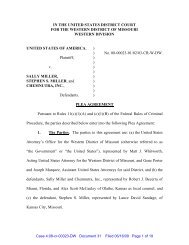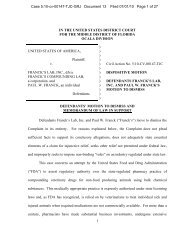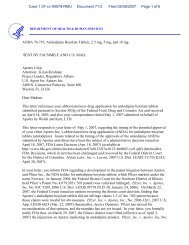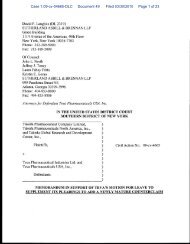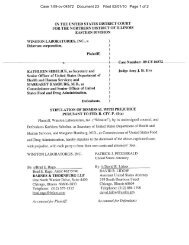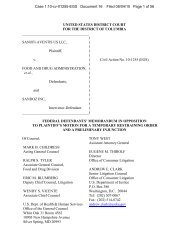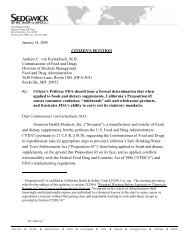first edition (1980) of the Orange Book - FDA Law Blog
first edition (1980) of the Orange Book - FDA Law Blog
first edition (1980) of the Orange Book - FDA Law Blog
Create successful ePaper yourself
Turn your PDF publications into a flip-book with our unique Google optimized e-Paper software.
approved application, a list <strong>of</strong> application holders including an abbreviatedname designation, and an appendix <strong>of</strong> drug products still being evaluated foreffectiveness in <strong>the</strong> Drug Efficacy study Implementation (DESI) program.A complete discussion <strong>of</strong> <strong>the</strong> background and basis <strong>of</strong> <strong>FDA</strong>'s <strong>the</strong>rapeuticequivalence evaluation policy was p..1blished as a proposal in <strong>the</strong> FederalRegister on January 12, 1979 (44 FR 2932) . The final rule, which includes<strong>FDA</strong>'s responses to <strong>the</strong> p..1blic comnents rece i ved on <strong>the</strong> proposal, wasrecently published in <strong>the</strong> Federal Register.B. DEFINITIONSApproved Prescription Drug Products - This term refers to currentlymarketed prescription drug products approved by <strong>FDA</strong> through new drugapplications (NDA's) or abbreviated new drug applications (ANDA' s) under <strong>the</strong>provisions <strong>of</strong> section 505 <strong>of</strong> <strong>the</strong> Federal Food, Drug, and Cognetic Act (<strong>the</strong>act) or, in <strong>the</strong> case <strong>of</strong> antibiotics, through analogous applications known asForms 5 or Forms 6 under section 507 <strong>of</strong> <strong>the</strong> act. All drug products on <strong>the</strong>List have been fully reviewed and awroved for safety and effectiveness by<strong>FDA</strong>. The law also permits drugs to be legally marketed without such fullyapproved applications under certain circumstances, but <strong>the</strong> drugs so marketeddo not appear on <strong>the</strong> List. They consist primarily <strong>of</strong>: 1) drugs marketedprior to 1938 that are rot subject to <strong>the</strong> pre-market clearance procedures <strong>of</strong><strong>the</strong> law, and 2) drug products marketed between 1938 and 1962 that wereapproved for safety but rot effectiveness ("deemed awroved") and are stillbeing reviewed under <strong>the</strong> administrative procedures <strong>of</strong> <strong>the</strong> Drug EfficacyStudy Implementaticn (DESI) program. The drug products still in <strong>the</strong> DESIadministrative process are listed in an awendix to <strong>the</strong> List.Pharmaceutical Equivalents Drug products are considered to bepharmaceutical equivalents if <strong>the</strong>y contain <strong>the</strong> same active ingredients andare identical in strength, dosage form, and route <strong>of</strong> administration (e.g.,chlordiazepoxide HCl, 5 mg. capsules, made by tVXl or more different manufacturers). pharmaceutically equivalent drug products, sometimes calledchemical equivalents, are formulated to contain <strong>the</strong> same amount <strong>of</strong> activeingredient in <strong>the</strong> same dosage form and to meet <strong>the</strong> same or comparablestandards (i.e. identity, strength, p..1rity and quality), but <strong>the</strong>y may differin characteristics such as color, taste, shape, packaging, expiration time,and, within ce,ttain limits, labeling.Pharmaceutical Alternatives - Drug products are considered to bepharmaceutical alternatives if <strong>the</strong>y contain <strong>the</strong> same <strong>the</strong>rapeutic moiety butdiffer in <strong>the</strong> salt or ester <strong>of</strong> that moiety or in <strong>the</strong> dosage form or strengthI - 3



